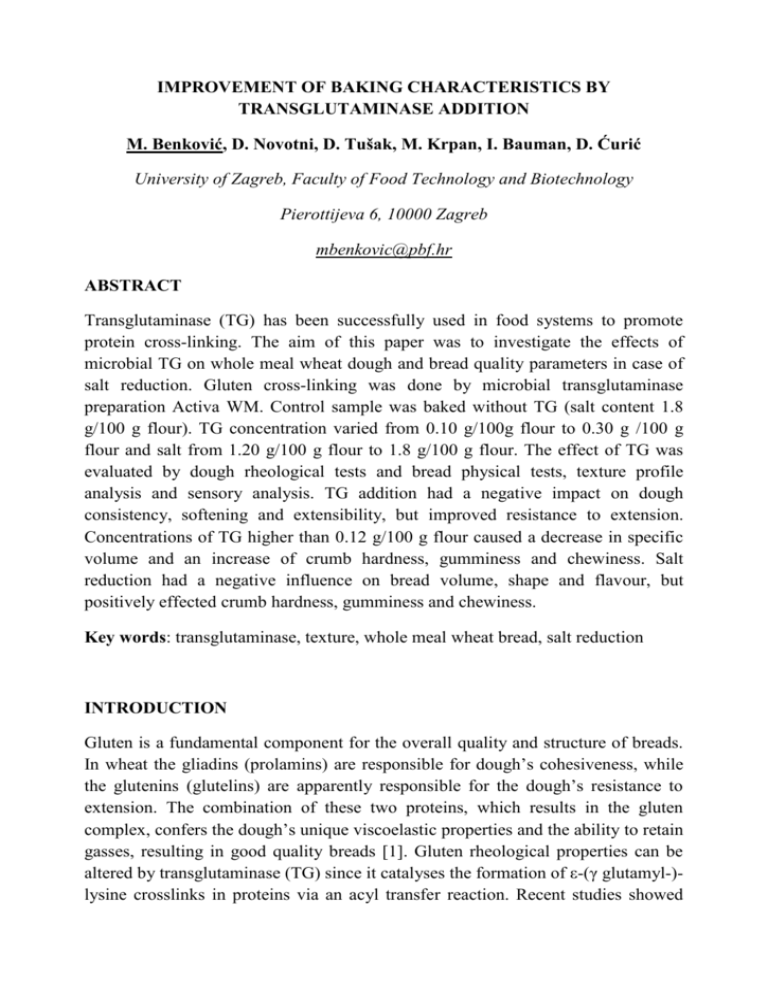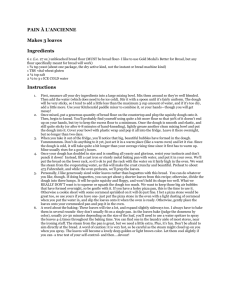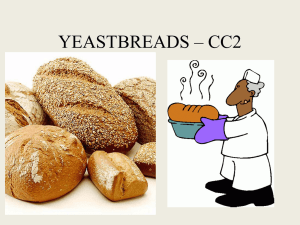Improvement of baking characteristics by transglutaminase addition
advertisement

IMPROVEMENT OF BAKING CHARACTERISTICS BY TRANSGLUTAMINASE ADDITION M. Benković, D. Novotni, D. Tušak, M. Krpan, I. Bauman, D. Ćurić University of Zagreb, Faculty of Food Technology and Biotechnology Pierottijeva 6, 10000 Zagreb mbenkovic@pbf.hr ABSTRACT Transglutaminase (TG) has been successfully used in food systems to promote protein cross-linking. The aim of this paper was to investigate the effects of microbial TG on whole meal wheat dough and bread quality parameters in case of salt reduction. Gluten cross-linking was done by microbial transglutaminase preparation Activa WM. Control sample was baked without TG (salt content 1.8 g/100 g flour). TG concentration varied from 0.10 g/100g flour to 0.30 g /100 g flour and salt from 1.20 g/100 g flour to 1.8 g/100 g flour. The effect of TG was evaluated by dough rheological tests and bread physical tests, texture profile analysis and sensory analysis. TG addition had a negative impact on dough consistency, softening and extensibility, but improved resistance to extension. Concentrations of TG higher than 0.12 g/100 g flour caused a decrease in specific volume and an increase of crumb hardness, gumminess and chewiness. Salt reduction had a negative influence on bread volume, shape and flavour, but positively effected crumb hardness, gumminess and chewiness. Key words: transglutaminase, texture, whole meal wheat bread, salt reduction INTRODUCTION Gluten is a fundamental component for the overall quality and structure of breads. In wheat the gliadins (prolamins) are responsible for dough’s cohesiveness, while the glutenins (glutelins) are apparently responsible for the dough’s resistance to extension. The combination of these two proteins, which results in the gluten complex, confers the dough’s unique viscoelastic properties and the ability to retain gasses, resulting in good quality breads [1]. Gluten rheological properties can be altered by transglutaminase (TG) since it catalyses the formation of ε-(γ glutamyl-)lysine crosslinks in proteins via an acyl transfer reaction. Recent studies showed that TG addition had a significant influence on dough and bread textural properties. Basman et al. (2002) reported that TG addition at all levels generally resulted in stronger dough properties, but superior handling properties were observed especially at lower addition levels (less than 0.5 %) [2]. Nowadays, bakery industry is searching for ways to lower the concentrations of salt added to bread products. Salt influences gluten behaviour, decreases yeast activity in the dough, thus retarding gas production, and enhances bread flavour [3]. However, lowering the salt concentration usually results in inadequate dough rheology and bread sensory properties [3]. The aim of this research was to determine the effect of TG addition on textural and sensory properties of whole meal wheat bread and to see whether the addition of TG could also make up for reduced salt addition. MATERIALS AND METHODS Materials Whole meal wheat flour (Farina, Croatia) of ash content 1.9 % on dry matter basis and moisture content 13.6 %, was used for dough preparation and bread making. The flour was characterized by wet gluten content 18.8 %, farinograph water absorption 64 %, and maximum viscosity 890 AU. Tap water, compressed yeast (Kvasac d.o.o., Croatia), “Format improver” (Ireks Aroma, Croatia), salt (Solana Pag, Croatia) and transglutaminase preparation Activa WM (Ajinomoto Europe, Germany) with an activity of 100 U/g protein were also used for dough and bread making. Methods 1. Experimental plan Experimental plan was made using central composite design by Design Expert 7.1.3 software (Stat-Ease Inc., USA) as showed in Table 1. Table 1. Salt and transglutaminase concentrations in bread samples Sample 0 1 2 3 4 5 6 7 8 9 NaCl concentration (% w/w) 1.80 1.80 1.80 1.08 1.50 1.50 1.20 1.20 1.50 1.92 TG concentration (g TG/100 g flour) 0.00 0.10 0.30 0.20 0.34 0.20 0.30 0.10 0.06 0.20 2. Dough rheology Farinogram characteristics of the flours and dough containing different levels of microbial transglutaminase and salt were determined using ICC approved method [4]. Uni-axial extensibility of prepared dough samples was assesed by the Kieffer dough and gluten extensibility rig manufactured by Stable Micro Systems for TA.HDplus Texture Analyser. Resistance to extension (g) and extensibility (mm) were determined in tension mode by recording the peak force and the distance at the maximum and the extension limit [5]. 3. Bread making Control bread containing no TG was prepared by mixing whole meal wheat flour (1600g), tap water (1024 g), compressed yeast (48 g), salt and improver (16 g). TG and salt were added according to experimental design shown in Table 1. All ingredients were mixed in a spiral mixer (Diosna SP12, Germany) for 3 minutes at 90 rpm and 6 minutes at 180 rpm. After resting 10 minutes, bread dough was divided into 70 g pieces, rounded, and placed in proofing cabinet at 30 °C / 95 % RH for 85 minutes. Breads were baked at 190 °C for 15 minutes with 0.5 L steam at start and cooled at room temperature for 60 min. 4. Selected bread quality parameters Texture profile analysis in a double compression cycle was performed using TA.HDplus Texture analyser with a cylindrical 25 mm probe, 25 kg load cell, 50% penetration depth and a 30 s gap between compressions on two 12.5 mm thick slices. Bread volume was determined by a rapeseed displacement method (AACC Standard 10-05) and the ratio volume/mass (specific volume) was calculated. Bread height and diameter was measured by a calliper and the shape (height/diameter) was calculated [6]. Sensory characteristics of baked bread were assessed by a panel of five experts. RESULTS AND DISCUSSION 1. Dough rheology Farinogram and textural properties of prepared dough samples are shown in Table 2. Addition of TG had a significant (p < 0.05) influence on dough consistency, showing a decrease in consistency with higher concentrations of added TG. It also had an influence on dough softening (r=0.955), with dough being firmer as the TG concentration increased. These results, especially for consistency can be considered unexpected if we take into consideration the main purpose of TG, which is to form dough which has better handling characteristics. It also had a significant effect on dough extensibility and resistance to extensibility. Resistance to extension highly correlated to TG concentration (r=0.901). It had an opposite effect on extensibility with correlating coefficient r=-0.912. Extensibility decreased as TG concentrations increased. The resistance to extension ratio (R/E) positively correlated to increase of TG concentration (r=0.944). The similar results were reported by Caballero et al. [7]. Addition of TG had no significant influence on dough development time and stability. Table 2. Farinogram and textural properties of prepared dough samples Sample Consistency [FU] Softening [FU] Development time [min] Stability [min] 0 1 2 3 4 5 6 7 8 9 500 480 480 470 460 456.7 460 480 480 450 28 30 90 58 100 70 100 30 30 80 17 8 10 9.5 9 8.8 8.5 8.5 10.5 10 0 6 0 0 0 0 0 5.5 4.5 0 Resistance to extensibility (max) [g] 16.75±0.58 24.04±1.10 38.95±1.50 36.96±3.92 36.95±3.92 36.34±5.42 32.61±2,99 23.69±0.89 21.11±1.62 33.35±2.06 Extensibility [mm] 20.31±1.94 16.61±0.56 13.46±0.57 13.79±0.96 13.79±0.96 14.66±0.97 11.90±1.23 16.19±1.14 17.24±1.31 14.02±0.73 2. Bread physical and sensorial properties Effects of TG addition on specific volume, shape, resilience, springiness and cohesiveness are shown in Figure 1. Specific volume significantly decreased as the TG concentration increased (r=-0.923). The reason for this decrease in specific volume is crosslinking of the gluten network to form a firmer grid. The particular effect of TG on bread quality has been previously studied with contradictory results, and it seems to be tied with different factors such as the quantity of water used, the dose of TG [8], and the baking quality of flour [7]. Specific volume could probably be increased by changing the dough making and baking procedure, e.g. by adding more water. An effect of TG addition on bread shape was not significant but should not be neglected (p=0.065), and we can say that TG addition improved shape. Based on statistical analysis, samples containing higher concentrations of salt and TG had better shape. This is in agreement with results by Caballero et al (2007) who concluded that the addition of TG led to a significant increase in height/weight ratio and a decrease in specific volume [7]. Bread resilience and springiness were not significantly affected by TG addition. At the same time, salt had a negative effect on crumb resilience (r=-0.650). TG addition had a negative effect on bread cohesiveness (Figure 1). Specific volume, shape, resilience, springness, cohesiveness SPECIFIC VOLUME SHAPE RESILIENCE SPRINGINESS COHESIVENESS 3 2.5 2 1.5 1 0.5 0 Sample Figure 1. Specific volume, shape, resilience, springiness and cohesiveness of bread samples Increasing concentrations of TG led to a significant increase in bread hardness (r=0.854), gumminess and chewiness (Figure 2). However, this increase is not suitable for end user satisfaction. It is important to mention that both, salt and TG effected crumb hardness increase. As already shown, both negatively effected specific volume and significant correlation between bread volume and hardness was found (r=-0.856). From these results, we can conclude that TG was the most active during the proofing and initial baking phase, and not during the dough mixing procedure. Upon the optimisation done using Design Expert software, as far as bread physical properties are concerned, salt concentration can be lowered to 1.2 g/100 g flour with the addition of 0.12 g TG/100 g flour. Hardness, gumminess and chewiness Hardness Gumminess Chewiness 2500 2000 1500 1000 500 0 Sample Figure 2. Crumb hardness, gumminess and chewiness of bread samples Sensory properties of bread samples are shown in Figures 3 and 4. Higher TG concentrations had a negative impact on volume and taste, but it had no influence on the outer appearance, crumb and crust appearance and odour. Lowered salt concentrations had a negative effect on volume, odour, crumb and crust taste and crumb appearance. Judging on the sensory panel results, the optimal concentration of salt in bread was 1.8 g/100 g flour. 1,8 NaCl+0TG 1,8NaCl+0,3MTG Flavour 1,8NaCl+0,1TG 1,5NaCl+0,34TG Volume 5 4 3 2 1 0 1,08NaCl+0,2TG Appearance Crumb appearance Odour Figure 3. Sensory properties of bread samples (samples 0-4) 1,2NaCl+0,3TG 1,5NaCl+0,06TG 1,5NaCl+0,2TG 1,92NaCl+0,2TG 1,2NaCl+0,1TG Volume Flavour Odour 5 4 3 2 1 0 Appearance Crumb appearance Figure 4. Sensory properties of bread samples (samples 5-9) CONCLUSIONS The aim of this research was to determine the effect of TG addition on dough rheology and quality parameters of whole meal wheat bread and to see whether the addition of TG could also make up for reduced salt addition. TG addition significantly influenced dough consistency and extensibility, with dough consistency and extensibility being lower as the TG concentration increased. Bread specific volume significantly decreased as TG concentration increased, and crumb hardness significantly increased as both TG and salt concentrations increased. Optimal TG concentration for achieving desirable physical properties was 0.12 g TG/ 100 g flour while reducing salt addition to 1.2 g/100 g flour in comparison to 1.8 g/100 g flour mainly used in bread making. However, based on sensory analysis, the optimal salt concentration for production of whole meal wheat bread was 1.8 g/100g flour. REFERENCES [1] Renzetti, S.; Dal Bello, F.; Arendt, E.K. (2008) Microstructure, fundamental rheology and baking characteristics of batters and breads from different gluten-free flours treated with a microbial transglutaminase. J. Cereal Sci. 48, 33-45. [2] Basman, A.; Koksel, H.; K.W.Ng, P. (2002) Effects of increasing levels of transglutaminase on the rheological properties and bread quality characteristics of two wheat flours. Eur. Food. Res. Technol. 215, 419-424. [3] Lynch, E.J.; Dal Bello, F.; Sheehan, E.M.; Cashman, K.D.; Arendt, E.K. (2009) Fundamental studies on the reduction of salt on dough and bread characteristics. Food Res. Int. 42, 885 – 891 [4] ICC-Standard No.115/1 (1992). Method for using the Brabender Farinograph, Approved 1972., Revised 1992. International Association for Cereal Science and Technology. [5] Bollain, C.; Angioloni, A.; Collar, C. (2006) Relationship between dough and bread viscoelastic properties in enzyme supplemented wheat samples. J. Food Eng. 77, 665-671 [6] AACC approved Methods 9th Ed. (1998) AACC Method 10-05 Guidelines for Measurement of Volume by Rapeseed Displacement [7] Caballero, P.A.; Gomez, M.; Rossel, C. M. (2007) Bread quality and dough rheology of enzyme – supplemented wheat flour. Eur. Food. Res. Technol. 224, 525-534. [8] Collar, C.; Bollain, C.; Angioloni, A. (2005) Significance of microbial transglutaminase on the sensory, mechanical and crumb grain pattern of enzyme supplemented fresh pan breads. J. Food .Eng. 70, 479 - 488.





